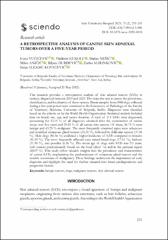A retrospective analysis of canine skin adnexal tumors over a five-year period

View/
Date
2025Author
Vučićević, Ivana
Kukolj, Vladimir
Nešić, Slađan
Aničić, Milan
Đurđević, Biljana
Marinković, Darko
Aleksić–Kovačević, Sanja
Metadata
Show full item recordAbstract
This research provides a retrospective analysis of skin adnexal tumors (SATs) in
canines, diagnosed between 2019 and 2023. The objective was to assess the prevalence,
classifi cation, and localization of these tumors. Tissue samples from 3886 dogs collected
during a fi ve-year period were examined at the Laboratory of Pathology of the Faculty
of Veterinary Medicine, University of Belgrade, Serbia. Diagnoses were classifi ed
based on the criteria set by the World Health Organization. Statistical analysis included
data on breed, sex, age, and tumor location. A total of 511 SATs were diagnosed,
accounting for 13.15 % of all diagnoses obtained after the examination of canine
tissue over fi ve years and 31.43 % of all canine skin tumors. Of these, 56.75 % were
benign and 43.25 % malignant. The most frequently observed types were sebaceous
and modifi ed sebaceous gland tumors (55.38 %), followed by follicular tumors (37.96
%). Male dogs (56.36 %) exhibited a higher incidence of SATs compared to females
(41.10 %). The most frequently affected were mixed-breed dogs (17.61 %), bichons
(11.55 %), and poodles (6.26 %). The mean age of dogs with SATs was 9.1 years,
with tumors predominantly found on the head (26.61 %) and in the perianal region
(24.07 %). This study offers valuable insights into the prevalence and characteristics
of canine SATs, emphasizing the predominance of sebaceous gland tumors and the
notable occurrence of malignancy. These fi ndings underscore the importance of early
diagnosis and highlight the need for further research into breed predispositions and
prognostic factors.
